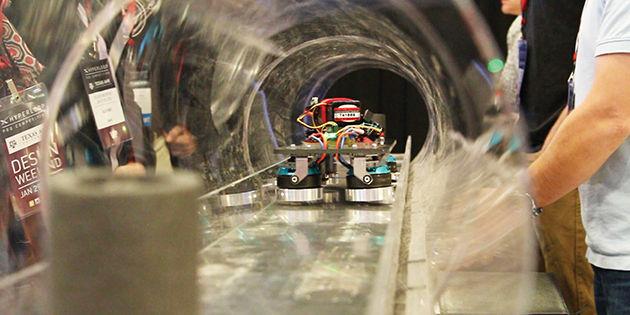While we’re waiting for “Beam me up, Scotty” transporter technology, the next best thing might turn out to be getting to a destination at the speed of a bullet.
When it comes down to it, we only have four modes of modern human transportation — planes, trains, automobiles and boats. We’ve come a long way from the horse-driven carriage, but there’s been nothing really new for more than a century until now.
For two days this past weekend, Texas A&M has been at the center of the world’s attention on an entirely new mode of transportation. More than 1,000 students from over 120 universities representing 21 countries descended on the Hall of Champions at Kyle Field to compete in the design of a revolutionary technology. It’s called Hyperloop, and it is the brainchild of Elon Musk, the visionary who has his long term sights on Mars while he leads the pack in commercial space and electric cars with his companies, SpaceX and Tesla.
Hyperloop is like a spacecraft flying near the ground. The idea is to fly through a tube that is pumped down to near vacuum conditions. Having nearly zero drag, a levitating bullet-like pod can be accelerated to speeds faster than commercial aircraft typically fly. Entirely powered by solar cells along the length of the track, the conceptual first-working Hyperloop might be a track from Los Angeles to San Francisco on which thousands of passengers could travel each day in about a half-hour for a 10th of the cost of airfare.
Is this really possible? Up until a few months ago, many were quite skeptical. But the SpaceX Hyperloop Design Weekend Competition at Texas A&M might have changed all that. The U.S. Secretary of Transportation Anthony Foxx gave a keynote address where he said he believes Hyperloop could be an important part of the solution to the ever-growing congestion on our nation’s transportation infrastructure. Along with SpaceX, investors from dozens of companies attended with the intent to sponsor promising teams to actually build their designs and race them this summer on a test track SpaceX is constructing near its facility in Hawthorne, California.
As one of 80 judges explained, “The competition was formidable” with some of the brightest students from top universities worldwide presenting designs for all aspects of the Hyperloop system, including levitation, aerodynamics, propulsion, braking, electronics and control systems. While the public enjoyed spectacular exhibits of the teams’ wide-ranging ideas, the judging process in the background was an intense academic challenge. All teams had to submit detailed reports prior to Design Weekend, and some of these were hundreds of pages of analytical, simulation and test results to prove their designs.
After two hours of deliberations among the lead judges, some winners emerged. Texas A&M students made us extremely proud by showcasing seven different team designs — double that of any other university.
In the end, one of our teams — “TAMU Aerospace Hyperloop” — won the top award for levitation systems and was among the top-22 teams selected to compete on the test track this summer. MIT took first place overall. The excitement at the awards ceremony was electric, with literally thousands of people watching from Kyle Field and around the world. A surprise appearance by Elon Musk capped off an amazing weekend and likely sent all the students home with dreams of the future and intensified passion for making Hyperloop a reality. When one day you find yourself commuting to work at the speed of sound, you’ll know it all started one very special weekend when students reinvented the future at Texas A&M.
Gregory Chamitoff is an aerospace engineering professor of practice and former astronaut. He was on the steering committee for the SpaceX Hyperloop Design weekend competition.


























